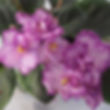
ABOUT AFRICAN
VIOLETS
African Violets are the world’s most popular indoor flowering plant, with their botanical origins going back to 19th century Africa. Most varieties now available are hybridised to produce thousands of different colours and varieties. All Jane’s plants are registered named varieties. Australian growers are hybridising, with many of these varieties in stock.
Available in every colour and shade, most African Violet flowers have 5 petals (single), 5-9 petals (semi-double), or multiple rows of 5 (double). The flowers may be single-colour, striped, edged or patterned and may have simple, clearly defined petals or may be frilled or fringed. Types include standards, miniatures, semi-miniatures and trailers.
In their natural habitat they enjoy filtered light, even temperatures, high humidity, ample moisture and well drained soil. Jane’s African Violets use a semi-hydroponic method of growing – by using “wick watering”, your African Violets can be fed and watered automatically as they require.
SUNLIGHT
By providing your African Violets with a suitable position and conditions your violets will thrive and give you beautiful flowers all year round. Good lighting is an essential element for African Violets. They prefer filtered sunlight from East or North windows. Too much sun may cause the leaves to become long and lanky, as well as loss of flowers.
African Violets need a bright, well-lit position, but not direct sunlight. They will grow towards the light and need to be turned regularly to keep a good shape. They are also grown under fluorescent lights. Lack of flowers and long petioles are signs of insufficient light. Pale foliage and tight growth indicates the light is too strong.


TEMPERATURE
Even temperatures are preferred, ranging between 18 and 27 degrees (C) with nights not below 15 degrees. They like humidity and fresh air, but not draughts. 50% humidity is ideal and wick watering helps provide this. Move them away from cold windows and rooms in winter. African Violets are comfortable and happy in temperatures we are comfortable in.
WATERING
Use room temperature water to water African Violets. Water from the bottom, by standing the pot in water for about half an hour then allowing to drain. Avoid watering the central leaves from the top.
Wick watering is the most popular method. A wick of artificial fibre leads from the pot to a reservoir filled with water. This allows the plant to take up the water, as it requires. An advantage of wick watering is fertiliser can be added to the reservoir and the plant is constantly fed.
Too much water can lead to wilt and rot and too little also causes the plant to wilt. If your plant has wilted, pick it up and use its weight to judge if it is too wet or too dry. If the plant is too wet, allow to stand on a towel or some newspaper.


NUTRIENTS AND HEALTH
Jane’s African Violets use a balanced nutrient added to all waterings to promote optimal leaf and flower production. Add nutrients to your wick watering system for optimum health. Fertiliser use gives a much healthier plant with more flowers. There are fertilisers specially formulated for African Violets. Add fertiliser to the reservoir and use wick watering.
African Violets flower best when pot bound, a pot 1/3 the span of the plant is ideal. Potting Mix should be a light soil-less mix. Commercial mixes are too heavy for wick watering as they hold too much water; adding perlite makes these mixes suitable.
Dust can be brushed off using a natural fibre brush eg pastry brush. Plants are healthier and more vigorous if repotted in fresh potting mix every 12 months. Side shoots distort the symmetry of the plant and should be removed.
PESTS AND MITES
Powdery Mildew, if caught early, can be washed off with warm water or use a fungicide. Yates Fungus Gun is suitable.
Cyclamen mite is the most damaging pest, an early sign of attack by mites is shriveling of the blossom. The stems become short and thicker and the crown hard and brittle. Spraying is essential to prevent the mites from spreading. Insects can be controlled with a miticide spray. Use personal protection according to the manufacturers instructions.


PROPAGATION
African Violets grow from a leaf. From one “mother” leaf approximately 6-12 “babies” will grow. These can be divided when they are large enough to support themselves with an adequate root system. They can then be divided into individual pots to grow. When large enough to fill a 70mm pot, pot up to a 100mm pot. This should be the largest size the plant requires for best growth. Minis grow best in 55mm pots.
